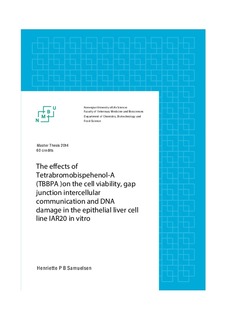| dc.description.abstract | Brominated flame retardants are released into the environment in many ways and have been shown to have negative effects on the health of living organisms. A disturbing increase in the use of the BFRs is considered a new environmental problem as many of the organic brominated compounds like tetrabromobisphenol A (TBBPA), polybrominated diphenyl ethers (PBDEs), hexa- bromocyclododecane (HBCD) and polybrominated biphenyls (PBBs) are persistent and lipophilic, leading to a potential accumulation in the fat tissue of living organisms. Elevated levels of TBBPA have been found in human blood, maternal- and cord serum, adipose tissue and breast milk. The latest years it has been of increasing interest to investigate the possible relationship between exposures to brominated flame retardants and the risk of cancer development.
The main objective of this thesis was to investigate the negative effects of the toxicants Tetrabromobispehenol-A (TBBPA), using the epithelial liver cell line IAR20 in vitro with special emphasis on cell viability, gap junction intercellular communication (GJIC) and DNA damage.
Concentrations ranging from 0,06 μM to 25 μM were tested in the current study, based on a pilot dose range-finding viability assay for TBBPA. The objective was demonstrated through the Alamar blue viability assay, the scrape dye-loading assay and the single-cell gel electrophoresis assay (Comet assay). The comet assay was performed with a smaller range of concentrations of TBBPA than that used in the scrape dye load assay and the AB assay, 1,25 μM, 2,5 μM, 5 μM, 10 μM, 15 μM and 20 μM was used as exposure concentrations. TBBPA exercised an inhibiting effect on the intercellular communication via gap junctions in the highest dose range. The cells remained viable up to an exposure of 15 μM TBBPA and showed to have a GJIC significantly different from the negative control starting from 2,5 μM and up. This shows that the cells continued to be viable, but didn’t communicate as well. The DNA damage in the cells was shown to be significant at a concentration of 2,5μM up to 20 μM.
In vitro results from this study cannot be directly compared to in vivo experiments, but it provides indications of exposure effects, as exposure to TBBPA for 24 hours can reduce cell viability, disrupt GJIC and cause DNA damage in IAR20 cells. | nb_NO |

